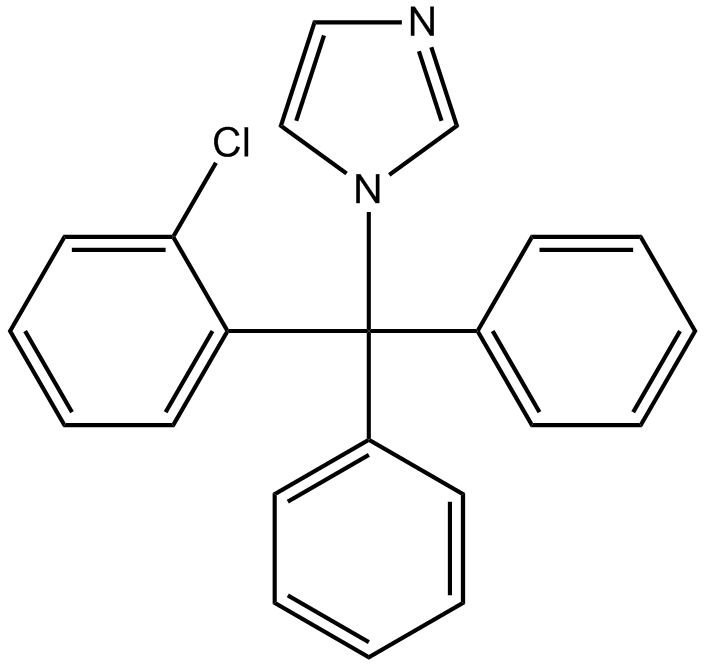Clotrimazole (Synonyms: BAYB5087, NSC 257473) |
| Catalog No.GC16804 |
antifungal compound
Products are for research use only. Not for human use. We do not sell to patients.

Cas No.: 23593-75-1
Sample solution is provided at 25 µL, 10mM.
Clotrimazole, bis-phenyl-(2-chlorophenyl)-1-imidazolyl methane, is a uniquely antifungal compound. In vitro, its spectrum includes dematiaceous, dermatophytes, dimorphic fungi and yeasts species. Its inhibitory concentrations in vitro were ≤ 4μg/mL for most susceptible fungi and ≤1 μg/mL for many species, particularly Trichophyton and Candida. Concentrations >20 μg/mL were fungicidal only [1]. It is also a specific Ca2+ activated K+ channel (Gardos channel) inhibitor [2]. Its IC50 to whole-cell currents in epithelial cells is 9 μmol/l [3].
Gardos channel contributes to pathologic water loss from erythrocytes and results in abnormal hemoglobin and promotes sickling in vitro. To avoid K+ and water loss via this channel was suggested as a potential therapy in vivo [2].
At concentrations ≤0.39 μg/mL, clotrimazole inhibited most isolates of C. neoformans, H. capsulatum and C. immitis. At concentrations < 0.78 μg/mL, clotrimazole did not inhibit one of C. neoformans. At 0.78 μg/mL, clotrimazole was fungicidal for all isolates, except a less susceptible isolate of H. capsulatum [1].
Subjects who had sickle cell anemia were treated with oral clotrimazole (10mg clotrimazole/kg/d for one week, and then daily dose was escalated by 10mg/kg each week). At a dosage of 20mg clotrimazole/kg/d, it was found that the Gardos channel was inhibited, cell K+ content was increased, erythrocyte dehydration was reduced, and hemoglobin levels was somewhat increased in all subjects. There are only three types of adverse effects, i.e. mild/moderate dysuria in all subjects and a reversible increase in plasma aspartic transaminase and alanine transaminase levels in two subjects treated with 30mg clotrimazole/kg/d [2].
References:
[1]. Smith Shadomy. In Vitro Antifungal Activity of Clotrimazole (Bay b 5097), Infection & Immunity. 1971, 4(2): 143-148.
[2]. Carlo Brugnara, Beatrice Gee, Carrie C. Armsby, et al. Therapy with Oral Clotrimazole Induces Inhibition of the Gardos Channel and Reduction of Erythrocyte Dehydration in Patients with Sickle Cell Disease. J. Clin. Invest., 1996, 97(5): 1227-1234.
[3]. Markus Bleich and Richard Warth. The very small-conductance K+ channel KVLQT1 and epithelial function. Pflügers Arch - Eur J Physiol, 2000, 440:202-206.
Average Rating: 5 (Based on Reviews and 35 reference(s) in Google Scholar.)
GLPBIO products are for RESEARCH USE ONLY. Please make sure your review or question is research based.
Required fields are marked with *




















